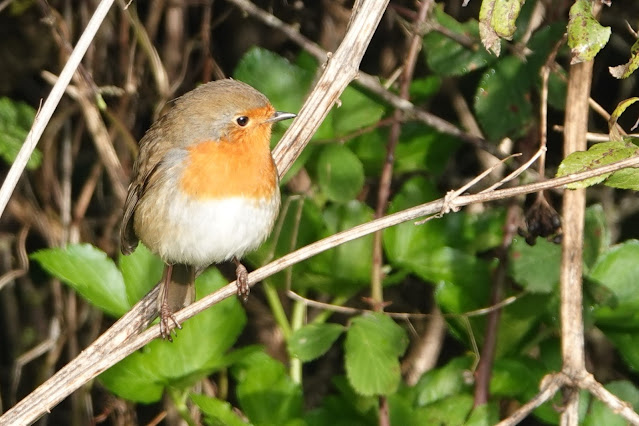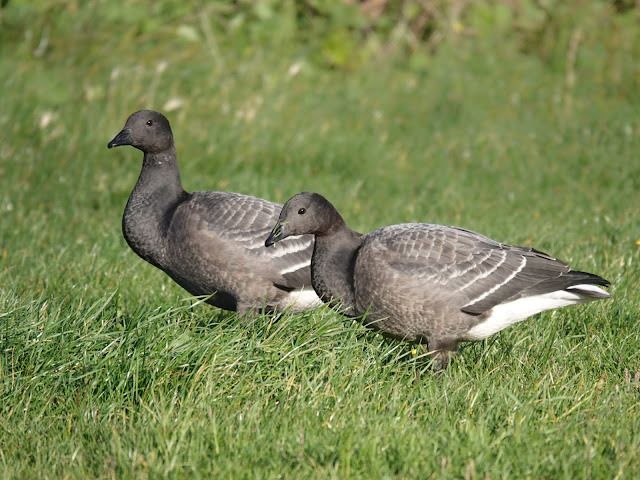Halloween was quite a bright day so I pottered down to Pakefield Beach. Ten Long-tailed Tits foraged with some Blue and Great Tits and a couple of Goldcrests but no stripy sprites were to be found. There were plenty of Robins though and a single brief Mealy Redpoll and the Blackbirds were still coveting the few Haws left.
 |
| Blackbird |
 |
| Robin |
 |
| Wood Pigeon |
 |
| Goldfinch |
 |
| Wood Pigeon |
Nerines seem to be a very popular Suffolk late autumn flower
bed species and there were still several banks of gleaming pink.
Back at home the first Long-tailed Tits moved through the
front of house Limes and the moth trap held four Light Brown Apple Moths,
Lesser Yellow Underwing, Silver-Y and Rusty Dot Pearl with both Common and
Beautiful Plumes in the garden herbage while Eristalis tenax and both Bombus
pascuorum and terrestris were on the last of the Yarrow and Purple Toadflax.
 |
| A Chestnut from my garden on the 27th |
 |
| and an Oak Rustic from Antony's |
Four adult Mute Swans whistle winged over the house late
afternoon adding another to the growing list.
The 1st November dawned very windy as the start
of Storm Ciaran made its way up the Channel and I spent a very productive
session from 0930-1000 down at Pakefield Beach sheltering in the lee of the big
Sycamore. Birds were moving and two imm
drake Goosander and a Guillemot close along the beach were both PB ticks and I
finished with 179 Dark-bellied Brent Geese, 24 Wigeon, six Teal, male Mallard,
five Scoter, 54 Gannet, and a good selection of waders too with 262 Dunlin, 37
Knot, Purple Sandpiper and Curlew.
Eighty Starlings arrived in off along with a single Skylark while 20
Greenfinch were foraging on the beach were there were a few less dog walkers
than usual.
The storm hit overnight but the urge to look at the sea was
overwhelming and Antony and I were at the Links Road car park by 0950 on the 2nd November and but
jauntily positioning the car we were able to have the windows down and scan the
raging sandy brown sea from the comfort of the car while the rain lashed down
and the wind shook the vehicle like a tenacious last autumn leaf .
Little Gulls were the ‘thing’ for the session with at least
81 seen getting blown north over the frothy cappuccino waves. Many seemed to be coming from just behind us
and I think they were being pushed slightly inland from Ness Point (where the breaking waves were towering over the sea wall!) before
fighting back to the sea half a mile north. Everything else was going south and
we notched up three Kittiwakes, Med Gull, Red-throated Diver, 22 Brent Geese,
12 Scoter, six Shelduck, seven Tufted Duck, five Golden Plover, Grey Plover,
two Dunlin and six Knot. The effortless
way that most of these birds battled into the wind was a joy to watch. A ball of 200 Starlings made it in but only
just, skimming the waves to reach landfall – another miraculous journey
accomplished.
Later on I gave Pakefield Beach a go between 1530 and 1550
before torrential rain forced a retreat but I did see my first local
Yellow-legged Gull – a third winter and five Little Gulls and a Common Scoter
headed south.
The day after a big storm is often the time to find the
windblown strays so I dragged myself down to Pakefield Beach and was ensconced
at my spot by 0655. It was still windy
but there was little moving but it was worth my hour with a cracking 1w female
Velvet Scoter flying along the beach and into the bay. She was not the Mutford Lock bird as she was
paddling around Hamilton Dock at the same time.
 |
| Velvet Scoter |
A 1w Caspian Gull flew by and six Little Gulls twisted in
and out of the waves along the sand bar while out to sea there were literally
hundreds of Cormorants heading out to feed somewhere to the south and I reckon
at least 600 were present. Three Wigeon and a female Common Scoter were also
seen along with two juvenile Brent Geese that were initially on the beach
before relocating to the greensward on top of the cliffs where they fed amongst
the dog walkers with no fear whatsoever.
Hopefully they would know when to move off. They were very approachable and the storm
must have separated them from the their parents leaving them without their
invaluable survival advice.
 |
| Brent Geese |
 |
| Brent Geese - Antony Wren |
Both Mealy and Lesser Redpoll were seen along with two
Siskin, ten Meadow Pipits and a bounding Grey Wagtail.
Back at home a vocal Grey Heron was new and a late female
Tachina fera was briefly potted so that I could look at claw to last foot
segment ratios to discover if I had found the almost identical species recently
found in Suffolk!
 |
| Tachina fera |
 |
| Tachina fera |
Saturday was an entertaining friends at home day which allowed
some time to pop out for a while this morning.
We started at Mutford Lock where the female Velvet Scoter conveniently
flew in as we turned up and put on a star performance for us along with an
immature Shag that we subsequently found out is an Isle of May colour ringed
bird. A Kingfisher dashed under the
bridge and a Little Egret was trying to follow the movements of the Shag along
the shore in the hope of fry being pushed to within striking distance.
 |
| Velvet Scoter |
 |
| Velvet Scoter |
 |
| Shag |
 |
| Little Egret |
On to Links Road for a look at the sea which was flat
calm. A few Gannets and Cormorants were
all we managed for our efforts along with a single Curlew and Brent Goose and a
calling Snow Bunting that snuck past us.
Several Med Gulls were loafing around as usual.
Ness Point only held the roving Bird’s Eye Turnstone flock
but no Purple Sandpipers and we were then lured away to look for a flock of
local Waxwings that had already moved once again but I am sure that they will
settle in this winter given the numbers drifting south at the moment.
 |
| Turnstone |
A cup of coffee at Carlton Marshes and then a walk down towards Peto’s. The marsh was lacking in any wildfowl at all
which was odd but we did see a few Lapwing and a single Snipe along with quite
a few raptors with five female type Marsh Harriers, three Buzzards, two Red
Kites and a Kestrel.
A Cetti’s Warbler called and a pair of Stonechats were flycatching
from a bramble clump where the ginger backs of Chinese Water Deer grazed
without concern.
Two Great White Egrets slow chased each other across the
marsh as we said our farewells to the North Kent Lesvos Massive.
Fireworks were followed by some local Aurora chasing and either
our eyes and phones were rubbish or it was hiding from us as all we found was a
fantastic snaking Milky Way stretched across the heavens.










No comments:
Post a Comment